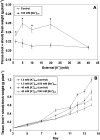Non-reciprocal interactions between K+ and Na+ ions in barley (Hordeum vulgare L.)
- PMID: 18562445
- PMCID: PMC2486474
- DOI: 10.1093/jxb/ern139
Non-reciprocal interactions between K+ and Na+ ions in barley (Hordeum vulgare L.)
Abstract
The interaction of sodium and potassium ions in the context of the primary entry of Na(+) into plant cells, and the subsequent development of sodium toxicity, has been the subject of much recent attention. In the present study, the technique of compartmental analysis with the radiotracers (42)K(+) and (24)Na(+) was applied in intact seedlings of barley (Hordeum vulgare L.) to test the hypothesis that elevated levels of K(+) in the growth medium will reduce both rapid, futile Na(+) cycling at the plasma membrane, and Na(+) build-up in the cytosol of root cells, under saline conditions (100 mM NaCl). We reject this hypothesis, showing that, over a wide (400-fold) range of K(+) supply, K(+) neither reduces the primary fluxes of Na(+) at the root plasma membrane nor suppresses Na(+) accumulation in the cytosol. By contrast, 100 mM NaCl suppressed the cytosolic K(+) pool by 47-73%, and also substantially decreased low-affinity K(+) transport across the plasma membrane. We confirm that the cytosolic [K(+)]:[Na(+)] ratio is a poor predictor of growth performance under saline conditions, while a good correlation is seen between growth and the tissue ratios of the two ions. The data provide insight into the mechanisms that mediate the toxic influx of sodium across the root plasma membrane under salinity stress, demonstrating that, in the glycophyte barley, K(+) and Na(+) are unlikely to share a common low-affinity pathway for entry into the plant cell.
Keywords: Barley; compartmental analysis; cytosol; efflux; influx; potassium; radiotracers; salinity; salt stress; sodium.
Figures









Similar articles
-
The cytosolic Na+ : K+ ratio does not explain salinity-induced growth impairment in barley: a dual-tracer study using 42K+ and 24Na+.Plant Cell Environ. 2006 Dec;29(12):2228-37. doi: 10.1111/j.1365-3040.2006.01597.x. Plant Cell Environ. 2006. PMID: 17081255
-
A pharmacological analysis of high-affinity sodium transport in barley (Hordeum vulgare L.): a 24Na+/42K+ study.J Exp Bot. 2012 Apr;63(7):2479-89. doi: 10.1093/jxb/err419. Epub 2012 Jan 20. J Exp Bot. 2012. PMID: 22268152 Free PMC article.
-
Oxygen deficiency and salinity affect cell-specific ion concentrations in adventitious roots of barley (Hordeum vulgare).New Phytol. 2015 Dec;208(4):1114-25. doi: 10.1111/nph.13535. Epub 2015 Jun 22. New Phytol. 2015. PMID: 26094736
-
42K analysis of sodium-induced potassium efflux in barley: mechanism and relevance to salt tolerance.New Phytol. 2010 Apr;186(2):373-84. doi: 10.1111/j.1469-8137.2009.03169.x. Epub 2010 Jan 28. New Phytol. 2010. PMID: 20122133
-
Sodium efflux in plant roots: what do we really know?J Plant Physiol. 2015 Aug 15;186-187:1-12. doi: 10.1016/j.jplph.2015.08.002. Epub 2015 Aug 15. J Plant Physiol. 2015. PMID: 26318642 Review.
Cited by
-
Production of Low-Potassium Content Melon Through Hydroponic Nutrient Management Using Perlite Substrate.Front Plant Sci. 2018 Sep 19;9:1382. doi: 10.3389/fpls.2018.01382. eCollection 2018. Front Plant Sci. 2018. PMID: 30283488 Free PMC article.
-
The ability to regulate voltage-gated K+-permeable channels in the mature root epidermis is essential for waterlogging tolerance in barley.J Exp Bot. 2018 Jan 23;69(3):667-680. doi: 10.1093/jxb/erx429. J Exp Bot. 2018. PMID: 29301054 Free PMC article.
-
Comparison between Arabidopsis and Rice for Main Pathways of K(+) and Na(+) Uptake by Roots.Front Plant Sci. 2016 Jul 5;7:992. doi: 10.3389/fpls.2016.00992. eCollection 2016. Front Plant Sci. 2016. PMID: 27458473 Free PMC article. Review.
-
Comparative physiology of elemental distributions in plants.Ann Bot. 2010 Jun;105(7):1081-102. doi: 10.1093/aob/mcq027. Epub 2010 Apr 21. Ann Bot. 2010. PMID: 20410048 Free PMC article. Review.
-
Futile Na+ cycling at the root plasma membrane in rice (Oryza sativa L.): kinetics, energetics, and relationship to salinity tolerance.J Exp Bot. 2008;59(15):4109-17. doi: 10.1093/jxb/ern249. Epub 2008 Oct 14. J Exp Bot. 2008. PMID: 18854575 Free PMC article.
References
-
- Amtmann A, Gradmann D. Na+ transport in Acetabularia bypasses conductance of plasmalemma. Journal of Membrane Biology. 1994;139:117–125. - PubMed
-
- Amtmann A, Sanders D. Mechanisms of Na+ uptake by plant cells. Advances in Botanical Research. 1999;29:75–112.
Publication types
MeSH terms
Substances
LinkOut - more resources
Full Text Sources
Medical

